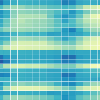Using mobility data as proxy for measuring urban vitality
Keywords:
spatial big data, mobility flows, urban vitality, temporal patterns, urban dynamicsAbstract
In this paper, we propose a computational approach to Jane Jacobs' concept of diversity and vitality, analyzing new forms of spatial data to obtain quantitative measurements of urban qualities frequently employed to evaluate places. We use smart card data collected from public transport to calculate a diversity value for each research unit. Diversity is composed of three dynamic attributes: intensity, variability, and consistency, each measuring different temporal variations of mobility flows. We then apply a regression model to establish the relationship between diversity and vitality, using Twitter data as a proxy for human activity in urban space. Final results (also validated using data sourced from OpenStreetMap) unveil which are the most vibrant areas in London.

Downloads
Published
Issue
Section
License
Copyright (c) 2018 Patrizia Sulis, Ed Manley, Chen Zhong, Michael Batty

This work is licensed under a Creative Commons Attribution 4.0 International License.
Articles in JOSIS are licensed under a Creative Commons Attribution 3.0 License.
